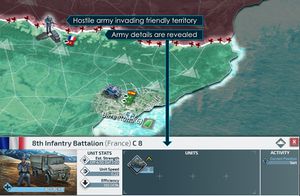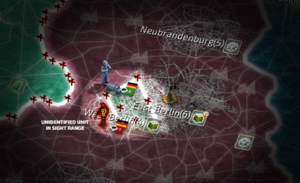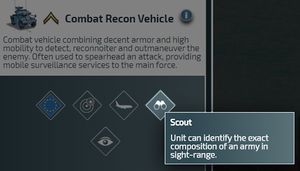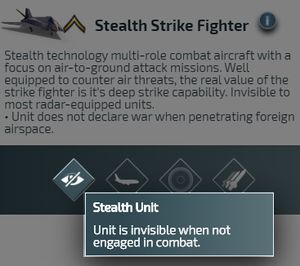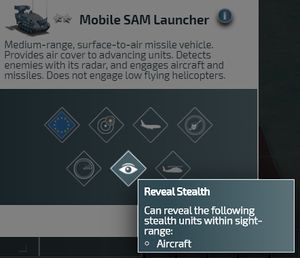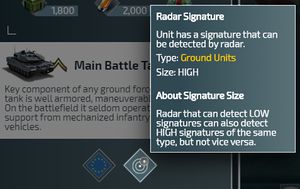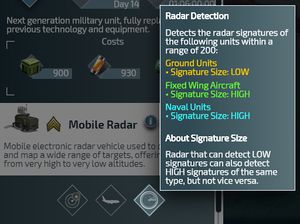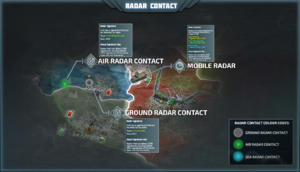Difference between revisions of "Field of View"
From Conflict of Nations Wiki
| (51 intermediate revisions by the same user not shown) | |||
| Line 1: | Line 1: | ||
__TOC__ | __TOC__ | ||
| − | + | <h2>Overview</h2> | |
| − | |||
| − | |||
| − | |||
| − | |||
| − | |||
| − | <h2> | ||
<div> | <div> | ||
| − | + | Reconnaissance is an important aspect in CON and mastering it is vital to any offensive strategy. This section provides an in-depth look at the two game systems that comprise reconnaissance: [[#Radar|Radar]] and [[#Sight Range|Sight-Range]]. | |
| + | <br> | ||
| + | IMPORTANT: These two systems work completely independent from each other. | ||
</div> | </div> | ||
| − | <h2> | + | <h2>Sight Range</h2> |
<div> | <div> | ||
| − | + | Sight-Range defines an area within which the fog of war is lifted and neutral/hostile armies are revealed. | |
| − | + | <ul> | |
| − | + | <li> Every unit has a sight-range which is specified in its [[User_Interface#Unit_Info_Panel|unit stats]]. | |
| − | + | <li> You have full sight-range in provinces that you own. | |
| − | + | <li> You have full sight-range in provinces that belong to coalition members and players with whom you [[Diplomatic_Status#Shared_Intelligence|share intelligence]]. | |
| − | + | </ul> | |
| + | Within sight-range, the visibility of neutral/hostile units is affected by two features: | ||
| + | <ul> | ||
| + | <li> [[#Camouflage & Scout|Camouflage]] | ||
| + | <li> [[#Stealth & Reveal Stealth|Stealth]] | ||
| + | </ul> | ||
</div> | </div> | ||
| − | < | + | <h3>Camouflage & Scout</h3> |
<div> | <div> | ||
| − | + | [[File: Sight-range_hostile-army-in-friendly-territory.jpg|thumb|right|300px|Hostile armies in friendly territory are always fully revealed.]] | |
| − | [[File: | + | [[File: Unidentifiedunit.png|thumb|right|300px|Neutral/Hostile armies outside friendly territory are unidentified in sight-range and marked with a question mark.]] |
| − | + | [[File: Unit-with-scout-feature.jpg|thumb|right|300px|Unit with the Scout feature.]] | |
| − | + | Camouflage obscures the details of an army that is within sight-range of another player and marks it as ''Unidentified''. This is automatic and applies to all units in the game, except naval units. | |
| − | + | <br> | |
| − | + | <ul> | |
| + | <li> When a hostile army enters your sight-range in friendly territory, i.e. provinces that belong to you or your coalition members, all its details are automatically revealed. | ||
| + | <li>When a neutral/hostile army enters your sight-range in neutral/hostile territory, i.e. provinces that do NOT belong to you or your coalition members, it is unidentified. That means you can see the army but not what type or how many units it is comprised of. | ||
| + | </ul> | ||
| + | An ''unidentified'' army's details can be revealed in two ways: | ||
| + | <ul> | ||
| + | <li> Research and mobilize a unit with the '''Scout''' feature. Any neutral/hostile army that is within sight-range of a friendly unit with the '''Scout''' feature has its details automatically revealed. | ||
| + | <li> Engage it in combat. | ||
| + | </ul> | ||
| + | <br> | ||
| + | Special cases when it comes to camouflage: | ||
| + | <ul> | ||
| + | <li> If you are being attacked by a hostile army outside your sight-range, e.g. by artillery that out-ranges you, it is revealed through the fog of war as an ''unidentified'' army. | ||
| + | <li> Naval fleets are always identified in sight-range. No scouting required. | ||
| + | </ul> | ||
</div> | </div> | ||
| − | <h3> | + | <h3>Stealth & Reveal Stealth</h3> |
<div> | <div> | ||
| − | + | A neutral/hostile unit with the '''Stealth''' feature is completely invisible to you in sight-range, and can infiltrate your territory without declaring war. | |
| − | + | <br> | |
| − | + | [[File: Unit-with-stealth-feature.jpg|thumb|right|300px|Unit with the Stealth feature.]] | |
| − | + | [[File: Unit-with-reveal-stealth-feature.jpg|thumb|right|300px|Unit with the Reveal Stealth feature against aircraft.]] | |
| − | + | A unit with the '''Stealth''' feature can only be revealed in two ways: | |
| − | + | <ul> | |
| − | + | <li> Research and mobilize a unit with the '''Reveal Stealth''' feature for the unit type you are trying to uncover (Ground, Air, or Naval). Any neutral/hostile unit that is within sight-range of a friendly unit with the '''Reveal Stealth''' feature is automatically revealed. | |
| − | + | <li> Engage it in combat. | |
| − | + | </ul> | |
| − | |||
| − | |||
| − | |||
| − | |||
| − | |||
| − | |||
</div> | </div> | ||
<h2>Radar</h2> | <h2>Radar</h2> | ||
<div> | <div> | ||
| − | + | Units that are equipped with [[#Radar Detection|radar]] can locate neutral/hostile units by detecting their [[#Radar Signature|radar signatures]].<br> | |
| − | |||
| − | |||
| − | |||
</div> | </div> | ||
| − | <h3> | + | <h3>Radar Signature</h3> |
<div> | <div> | ||
| − | + | [[File: Unit-with-radar-signature.jpg|thumb|right|300px|Unit with a HIGH, Ground Units radar signature.]] | |
| + | Almost every unit has a radar signature which consists of two attributes: Type and size. | ||
| + | <br> | ||
| + | Possible signature types: | ||
| + | <ul> | ||
| + | <li> Ground Units | ||
| + | <li> Fixed Wing Aircraft | ||
| + | <li> Rotary Wing Aircraft | ||
| + | <li> Naval Units | ||
| + | </ul> | ||
| + | Possible signature sizes: | ||
| + | <ul> | ||
| + | <li> HIGH | ||
| + | <li> LOW | ||
| + | </ul> | ||
| + | Every unit with a radar signature has a feature tool-tip that lists its signature attributes. Units without a radar signature feature cannot be detected by any radar. | ||
</div> | </div> | ||
| − | <h3> | + | <h3>Radar Detection</h3> |
<div> | <div> | ||
| − | + | [[File: Unit-with-radar-detection.jpg|thumb|right|300px|Unit with radar feature.]] | |
| + | [[File: Radar Infograph.png|thumb|right|300px|Radar detecting radar signatures.]] | ||
| + | Every unit equipped with radar can detect certain [[#Radar Signature|radar signatures]]. The Radar feature tool-tip lists what kind of [[#Radar Signature|radar signatures]] it can detect within a specified range. | ||
| + | <ul> | ||
| + | <li> When a neutral/hostile unit with the correct signature type and size enters your radar's range it is automatically located and shows up on the map as a radar blip. | ||
| + | <li> The blip color corresponds to the signature type that has been detected. | ||
| + | </ul> | ||
| + | Radar systems that can detect a LOW signature of a given type can also detect its HIGH signature. | ||
| + | <ul> | ||
| + | <li> E.g. if a unit's radar can detect LOW Fixed Wing Aircraft signatures, it can also detect HIGH Fixed Wing Aircraft signatures. | ||
| + | </ul> | ||
| + | An army that consists of a mix of units with HIGH and LOW radar signatures can be located by radar capable of detecting HIGH signatures. | ||
</div> | </div> | ||
| − | < | + | <h2>Air Patrol</h2> |
<div> | <div> | ||
| − | + | Air units can use the patrol feature to automatically attack enemy units if they are within patrol range. | |
| − | + | <ul> | |
| + | <li> When you give the patrol command, a blue circle marks the patrol area. | ||
| + | <li> Hostile units that enter the patrol area will be automatically attacked. | ||
| + | <li> <p> Patrolling aircraft will have to go back to base to refuel after a certain amount of time to be able to keep patrolling. This timer starts the moment the Aircraft leaves the base, so the shorter the distance between the Patrol area and the Airbase is, the longer the Patrol time will be. </p> | ||
| + | <li> <p> The amount of fuel they can carry is unique to each unit type. The Timer details are shown in the Unit info panel. </p> | ||
| + | <li> <p> Aircraft will always return to refuel in its originating Base. </p> | ||
| + | </ul> | ||
</div> | </div> | ||
| − | <h2> | + | <h2> Ferrying </h2> |
<div> | <div> | ||
| − | + | Ferrying is a great way of re-positioning your aircraft to gain a strategic advantage. | |
| − | + | ||
| + | Aircraft who are sent to a province/city which does not contain an airbase/airport will use the closest airport to the destination and travel via transport truck for the duration of the distance. If an aircraft unit is on the way to a city which has it's airbase destroyed mid-flight, the aircraft will ferry back (via air-flight) to the closest airbase and refuel. You might also come across a situation where the airbase your aircraft is using is destroyed, as a result your aircraft will turn into a transport truck. You will need to ferry it to a closeby city or province which houses an airbase/airport but keep in mind that transport trucks are fairly slow and your units are susceptible to being picked off easily. Alternatively you can rebuild/repair the base it was originally using. When the aircraft successfully ferries, it will permanently change its location of re-fueling to the current airport, this means that the respective base/port is acting as a base of operations for the aircraft situated in it. | ||
</div> | </div> | ||
Latest revision as of 02:24, 2 November 2022
Contents
Overview
Reconnaissance is an important aspect in CON and mastering it is vital to any offensive strategy. This section provides an in-depth look at the two game systems that comprise reconnaissance: Radar and Sight-Range.
IMPORTANT: These two systems work completely independent from each other.
Sight Range
Sight-Range defines an area within which the fog of war is lifted and neutral/hostile armies are revealed.
- Every unit has a sight-range which is specified in its unit stats.
- You have full sight-range in provinces that you own.
- You have full sight-range in provinces that belong to coalition members and players with whom you share intelligence.
Within sight-range, the visibility of neutral/hostile units is affected by two features:
Camouflage & Scout
Camouflage obscures the details of an army that is within sight-range of another player and marks it as Unidentified. This is automatic and applies to all units in the game, except naval units.
- When a hostile army enters your sight-range in friendly territory, i.e. provinces that belong to you or your coalition members, all its details are automatically revealed.
- When a neutral/hostile army enters your sight-range in neutral/hostile territory, i.e. provinces that do NOT belong to you or your coalition members, it is unidentified. That means you can see the army but not what type or how many units it is comprised of.
An unidentified army's details can be revealed in two ways:
- Research and mobilize a unit with the Scout feature. Any neutral/hostile army that is within sight-range of a friendly unit with the Scout feature has its details automatically revealed.
- Engage it in combat.
Special cases when it comes to camouflage:
- If you are being attacked by a hostile army outside your sight-range, e.g. by artillery that out-ranges you, it is revealed through the fog of war as an unidentified army.
- Naval fleets are always identified in sight-range. No scouting required.
Stealth & Reveal Stealth
A neutral/hostile unit with the Stealth feature is completely invisible to you in sight-range, and can infiltrate your territory without declaring war.
A unit with the Stealth feature can only be revealed in two ways:
- Research and mobilize a unit with the Reveal Stealth feature for the unit type you are trying to uncover (Ground, Air, or Naval). Any neutral/hostile unit that is within sight-range of a friendly unit with the Reveal Stealth feature is automatically revealed.
- Engage it in combat.
Radar
Units that are equipped with radar can locate neutral/hostile units by detecting their radar signatures.
Radar Signature
Almost every unit has a radar signature which consists of two attributes: Type and size.
Possible signature types:
- Ground Units
- Fixed Wing Aircraft
- Rotary Wing Aircraft
- Naval Units
Possible signature sizes:
- HIGH
- LOW
Every unit with a radar signature has a feature tool-tip that lists its signature attributes. Units without a radar signature feature cannot be detected by any radar.
Radar Detection
Every unit equipped with radar can detect certain radar signatures. The Radar feature tool-tip lists what kind of radar signatures it can detect within a specified range.
- When a neutral/hostile unit with the correct signature type and size enters your radar's range it is automatically located and shows up on the map as a radar blip.
- The blip color corresponds to the signature type that has been detected.
Radar systems that can detect a LOW signature of a given type can also detect its HIGH signature.
- E.g. if a unit's radar can detect LOW Fixed Wing Aircraft signatures, it can also detect HIGH Fixed Wing Aircraft signatures.
An army that consists of a mix of units with HIGH and LOW radar signatures can be located by radar capable of detecting HIGH signatures.
Air Patrol
Air units can use the patrol feature to automatically attack enemy units if they are within patrol range.
- When you give the patrol command, a blue circle marks the patrol area.
- Hostile units that enter the patrol area will be automatically attacked.
-
Patrolling aircraft will have to go back to base to refuel after a certain amount of time to be able to keep patrolling. This timer starts the moment the Aircraft leaves the base, so the shorter the distance between the Patrol area and the Airbase is, the longer the Patrol time will be.
-
The amount of fuel they can carry is unique to each unit type. The Timer details are shown in the Unit info panel.
-
Aircraft will always return to refuel in its originating Base.
Ferrying
Ferrying is a great way of re-positioning your aircraft to gain a strategic advantage.
Aircraft who are sent to a province/city which does not contain an airbase/airport will use the closest airport to the destination and travel via transport truck for the duration of the distance. If an aircraft unit is on the way to a city which has it's airbase destroyed mid-flight, the aircraft will ferry back (via air-flight) to the closest airbase and refuel. You might also come across a situation where the airbase your aircraft is using is destroyed, as a result your aircraft will turn into a transport truck. You will need to ferry it to a closeby city or province which houses an airbase/airport but keep in mind that transport trucks are fairly slow and your units are susceptible to being picked off easily. Alternatively you can rebuild/repair the base it was originally using. When the aircraft successfully ferries, it will permanently change its location of re-fueling to the current airport, this means that the respective base/port is acting as a base of operations for the aircraft situated in it.
